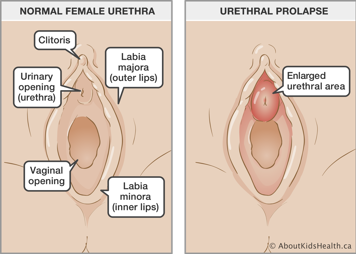What is urethral prolapse?
The urethra is the tube that connects the bladder to the outside of the body. Urine (pee) passes through the urethra. Urethral prolapse occurs when the inner lining of the urethra sticks out through the opening of the urethra. When this happens, the opening of the urethra looks like a small purple or red donut and seems larger than normal.
Urethral prolapse happens most commonly to school-aged girls before puberty.

Urethral prolapse causes swelling and irritation
Sometimes, there is bleeding from around the outside of the opening of the urethra. Usually, parents notice the condition when they see a small amount of blood in their child's diaper or underwear. It is often not painful for the child, but there can be some discomfort and pain when she urinates or wipes. Blood in the urine is uncommon.
Urethral prolapse can be caused by different things
The exact cause of urethral prolapse is not known. It may happen if the tissues around the urethra are weak. It often happens before puberty starts, when a girl has low levels of the hormone estrogen. Black and Hispanic girls are more at risk for getting urethral prolapse. It is also more likely to happen to girls who have a history of heavy coughing, constipation, obesity or genital trauma. All these conditions can increase pressure inside the belly, which may lead to urethral prolapse.
Diagnosing urethral prolapse
If your daughter has any bleeding from her urethra or any redness in the area, she should be seen by her doctor. Her doctor may then decide to refer her to a gynaecology or urology specialist.
The doctor will ask questions about your child's health. The doctor will also ask about recent coughing or constipation, which may have caused the prolapse.
Your daughter will also need a physical examination. Before your child is examined, the doctor will tell her what will happen during the examination. That way, your child will feel comfortable with the examination and will not have a painful or scary experience.
The doctor may also want to make sure there is no infection in the area. To do this, the doctor might take a small swab from the affected area. A swab is a small fluid sample taken with a cotton-tip swab.
The doctor will also want to make sure that your child can urinate without problems.
If there is bleeding and the doctor cannot see where it is coming from, more examinations may be needed. Examinations of this type are sometimes done under sedation. Sedation is medicine that makes your child sleepy and more comfortable.
Treating urethral prolapse
Estrogen cream
Your doctor may prescribe a hormone cream called Premarin. Premarin is an estrogen cream. Put a pea-sized amount directly on the reddened area once or twice a day. Use a cotton-tip swab or your fingertip.
Premarin is usually prescribed for a short time until the urethral prolapse gets better. If Premarin is used in large amounts or for a long time, your daughter's breasts may grow a little. This is a harmless and temporary side effect. Your child's breasts will return to the normal size when treatment with Premarin stops.
Sitz baths
A warm, shallow sitz bath twice a day for 15 to 20 minutes will help the urethral prolapse area heal and keep the area clean. Girls with urethral prolapse should not take bubble baths or use strong soaps. These can irritate the skin.
Antibiotics
The doctor will prescribe antibiotics only if your daughter also has an infection. Antibiotics do not treat the urethral prolapse itself.
Surgery
Sometimes, treatment with Premarin cream and sitz baths do not resolve the urethral prolapse or urethral prolapse comes back. Your doctor may suggest surgery to reduce the prolapse by pushing back the inner lining of the urethra that is sticking out or to remove the prolapse tissue if:
- the prolapse does not get better with cream and baths
- the prolapse gets better but then comes back
- your child has persistent bleeding from the prolapse, severe pain or trouble voiding (urinating)
If your child does need surgery, she will receive sedation for the operation. After the operation, your child may have a catheter in her urethra for a couple of days to help her urinate. She will be given pain medicine and should begin treatments with Premarin cream and sitz baths again.
Management of other conditions
Other conditions such as heavy coughing, constipation, obesity or genital trauma may lead to urethral prolapse. If one of these conditions is identified as a cause for your child’s urethral prolapse, it should be managed to prevent further episodes.
Stopping urethral prolapse from happening again
Sometimes, urethral prolapse happens again after treatment. Sometimes the urethral prolapse re-occurs when a child coughs or strains while going to the bathroom.
Here are some things you and your daughter can do to help prevent urethral prolapse from happening again:
- If your daughter is coughing a lot, talk to your doctor.
- Have your daughter drink lots of fluids and eat foods with lots of fibre. This will help prevent constipation, which can lead to straining while going to the bathroom. If your child becomes constipated, talk to your doctor or pharmacist about other medicines to help with constipation.
- Avoid strong deodorant soaps and bubble baths.
- Put a barrier cream such as petroleum jelly (Vaseline) on the area to keep it moist between uses of the Premarin cream.
- Have your daughter pat dry instead of wipe dry after using the bathroom.